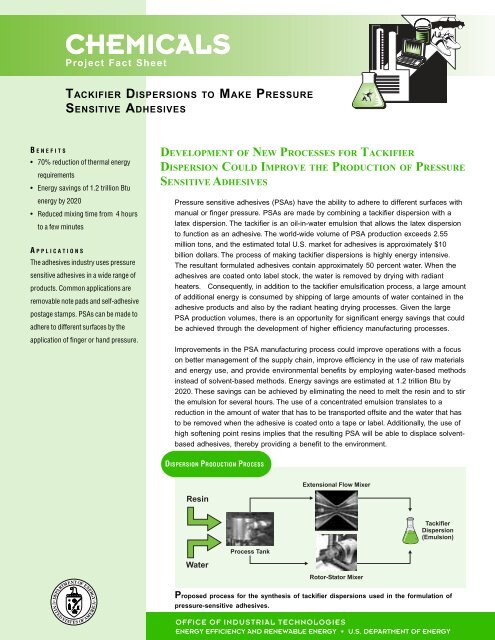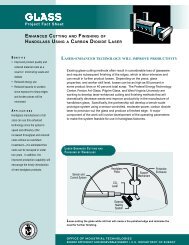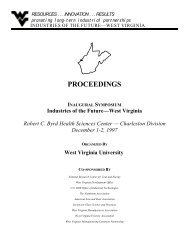tackifier dispersions to make pressure sensitive adhesives
tackifier dispersions to make pressure sensitive adhesives
tackifier dispersions to make pressure sensitive adhesives
You also want an ePaper? Increase the reach of your titles
YUMPU automatically turns print PDFs into web optimized ePapers that Google loves.
CHEMICALSProject Fact SheetTACKIFIER DISPERSIONS TO MAKE PRESSURESENSITIVE ADHESIVESB ENEFITS• 70% reduction of thermal energyrequirements• Energy savings of 1.2 trillion Btuenergy by 2020• Reduced mixing time from 4 hours<strong>to</strong> a few minutesA PPLICATIONSThe <strong>adhesives</strong> industry uses <strong>pressure</strong><strong>sensitive</strong> <strong>adhesives</strong> in a wide range ofproducts. Common applications areremovable note pads and self-adhesivepostage stamps. PSAs can be made <strong>to</strong>adhere <strong>to</strong> different surfaces by theapplication of finger or hand <strong>pressure</strong>.DEVELOPMENT OF NEW PROCESSES FOR TACKIFIERDISPERSION COULD IMPROVE THE PRODUCTION OF PRESSURESENSITIVE ADHESIVESPressure <strong>sensitive</strong> <strong>adhesives</strong> (PSAs) have the ability <strong>to</strong> adhere <strong>to</strong> different surfaces withmanual or finger <strong>pressure</strong>. PSAs are made by combining a <strong>tackifier</strong> dispersion with alatex dispersion. The <strong>tackifier</strong> is an oil-in-water emulsion that allows the latex dispersion<strong>to</strong> function as an adhesive. The world-wide volume of PSA production exceeds 2.55million <strong>to</strong>ns, and the estimated <strong>to</strong>tal U.S. market for <strong>adhesives</strong> is approximately $10billion dollars. The process of making <strong>tackifier</strong> <strong>dispersions</strong> is highly energy intensive.The resultant formulated <strong>adhesives</strong> contain approximately 50 percent water. When the<strong>adhesives</strong> are coated on<strong>to</strong> label s<strong>to</strong>ck, the water is removed by drying with radiantheaters. Consequently, in addition <strong>to</strong> the <strong>tackifier</strong> emulsification process, a large amoun<strong>to</strong>f additional energy is consumed by shipping of large amounts of water contained in theadhesive products and also by the radiant heating drying processes. Given the largePSA production volumes, there is an opportunity for significant energy savings that couldbe achieved through the development of higher efficiency manufacturing processes.Improvements in the PSA manufacturing process could improve operations with a focuson better management of the supply chain, improve efficiency in the use of raw materialsand energy use, and provide environmental benefits by employing water-based methodsinstead of solvent-based methods. Energy savings are estimated at 1.2 trillion Btu by2020. These savings can be achieved by eliminating the need <strong>to</strong> melt the resin and <strong>to</strong> stirthe emulsion for several hours. The use of a concentrated emulsion translates <strong>to</strong> areduction in the amount of water that has <strong>to</strong> be transported offsite and the water that has<strong>to</strong> be removed when the adhesive is coated on<strong>to</strong> a tape or label. Additionally, the use ofhigh softening point resins implies that the resulting PSA will be able <strong>to</strong> displace solventbased<strong>adhesives</strong>, thereby providing a benefit <strong>to</strong> the environment.DISPERSION PRODUCTION PROCESSExtensional Flow MixerResinTackifierDispersion(Emulsion)WaterProcess TankRo<strong>to</strong>r-Sta<strong>to</strong>r MixerProposed process for the synthesis of <strong>tackifier</strong> <strong>dispersions</strong> used in the formulation of<strong>pressure</strong>-<strong>sensitive</strong> <strong>adhesives</strong>.OFFICE OF INDUSTRIAL TECHNOLOGIESENERGY EFFICIENCY AND RENEWABLE ENERGY • U.S. DEPARTMENT OF ENERGY
Project DescriptionGoal: To develop an energy efficient process for making commercial-quality <strong>tackifier</strong><strong>dispersions</strong>.The current process for <strong>tackifier</strong> dispersion manufacture begins by melting the resin <strong>to</strong> form awater-in-oil emulsion, which is then converted <strong>to</strong> an oil-in-water emulsion by phase-inversionin the presence of continuous stirring. The resulting emulsion is not concentrated and theremaining excess water has <strong>to</strong> be transported and removed.The main barrier <strong>to</strong> overcome in the development of commercial quality <strong>tackifier</strong> <strong>dispersions</strong>is the inability <strong>to</strong> directly emulsify resin in water. The viscosity of the resin phase is so largecompared <strong>to</strong> the aqueous phase that resin droplets cannot be broken down <strong>to</strong> small sizes bythe shear stress transmitted by the water phase. Possible solutions <strong>to</strong> circumvent this barrierinclude (i) the use of mixers that do not use strictly laminar shear flow and perhaps alsogenerate turbulence, (ii) mixers that employ an extensional flow field that is not limited ineffectiveness by the ratio of the dispersed phase viscosity <strong>to</strong> the continuous phase viscosity,(iii) reducing the resin <strong>to</strong> a powder form with the correct size and size distribution beforedispersion in water, and (iv) direct emulsification of the <strong>tackifier</strong> resin in the latex dispersionwithout the intermediate step of formulating a <strong>tackifier</strong> dispersion.Progress and Miles<strong>to</strong>nesThe project plan is divided in<strong>to</strong> five tasks as outlined below.• Improvement of the current process• Direct emulsification of resin in water using an Extensional Flow Mixer• Comminution of resin followed by emulsification• Single-step synthesis of PSAs• Rheological CharacterizationCommercializationTwo project partners, Mays Microsystems and Charles Ross and Son Company, areparticipating in the project with the sole purpose of commercializing the new technology andmaking it available as widely as possible.PROJECT PARTNERSWest Virginia UniversityMorgan<strong>to</strong>wn, WVDyna-Tech Adhesives, Inc.Graf<strong>to</strong>n, WVCharles Ross & Son CompanyHauppauge, NYMays Microsystems, Inc.Millburn, NJArgonne National Labora<strong>to</strong>ryArgonne, ILTulane UniversityNew Orleans, LAFOR ADDITIONAL INFORMATION,PLEASE CONTACT:Brian ValentineOffice of Industrial TechnologiesPhone: (202) 586-1739Fax: (202) 586-1658E-mail: brian.valentine@ee.doe.govRakesh K. GuptaDepartment of Chemical EngineeringWest Virginia University(304) 293-2111 ext 2427Please send any comments,questions, or suggestions <strong>to</strong>webmaster.oit@ee.doe.govVisit our home page atwww.oit.doe.govOffice of Industrial TechnologiesEnergy Efficiencyand Renewable EnergyU.S. Department of EnergyWashing<strong>to</strong>n, D.C. 20585February 2003






